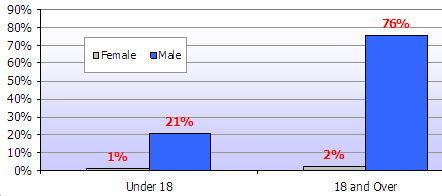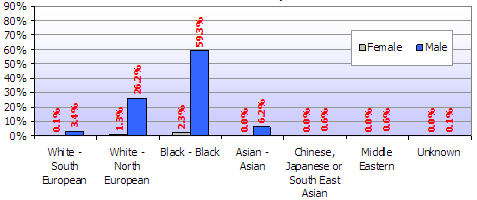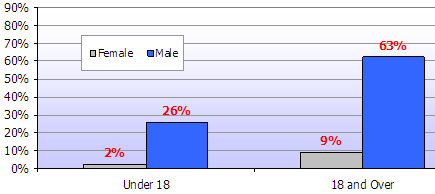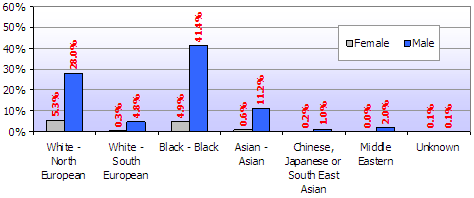Contents
Report 5 of the 17 May 2010 meeting of the Communities, Equalities and People Committee, with details of the policing of women, weapons and serious youth violence.
Warning: This is archived material and may be out of date. The Metropolitan Police Authority has been replaced by the Mayor's Office for Policing and Crime (MOPC).
See the MOPC website for further information.
Policing Women, Weapons and Serious Youth Violence
Report: 5
Date: 17 May 2010
By: AC Specialist Crime and AC Territorial Policing on behalf of the Commissioner
Summary
This report is in response to the MPA request around the policing of women, weapons and serious youth violence. The report provides information regarding women and girls report for, cautioned for and charged with gun and knife offences for the year to date. Aggregates related data in terms of age, ethnicity and compares it to comparative data for males. The report draws on previous work in relation to the Gangs Stocktake, Youth Strategy and other academic work in this field. It updates members on engagement activity and future plans including exit strategies for those women wishing to withdraw from gang cultures. The Commissioning Brief requests information around conviction statistics for the said offences which is not easily accessible within the MPS but is the responsibility of the Ministry of Justice
A. Recommendation
Members note the contents of the report:
B. Supporting information
Relevant Performance Information
1. The data referred to in this report covers the reporting period of 1 February 2009 until 31 January 2010. During this period:
- No females have been reported for carrying a firearm or knife during the period in question
- No females have been cautioned for carrying a firearm and 27 cautioned for knife crime offences
- There have been 150 women and girls charged with carrying a weapon and of these, 18 were for carrying a firearm and 132 for carrying a knife
- Conviction data is not collated within the MPS as this is the responsibility of the Ministry of Justice
2. The following provides a breakdown for the period 1 February 2009 to 31 January 2010 for gun crime offences. Table 1 provides the gender breakdown, Table 2 gives the breakdown by age and gender and Table 3 the ethnic and gender breakdown for Gun Crime offences.
Table 1: Gun Crime 1 February 2009 to 31 January 2010: Persons Accused - Gender Breakdown

Table 2: Gun Crime 1 February 2009 to 31 January 2010: Persons Accused - Age Breakdown

Table 3: Gun Crime 1 February 2009 to 31 January 2010: Persons Accused - Ethnicity Breakdown

3. The following provides a breakdown for the period 1 February 2009 to 31 January 2010 for knife crime offences. Table 4 provides the gender breakdown, Table 5 gives the breakdown by age and gender and Table 6 gives the ethnic and gender breakdown for Knife Crime offences.
Table 4: Knife Crime 1 February 2009 to 31 January 2010: Persons Accused - Gender Breakdown

Table 5: Knife Crime 1 February 2009 to 31 January 2010: Persons Accused - Age Breakdown

Table 6: Knife Crime 1 February 2009 to 31 January 2010: Persons Accused - Age Breakdown

Gangs Stocktake
4. The MPS gang’s stock take was about gangs and violence and did not encompass issues solely about women and weapon use. Recommendations made were not specifically about females but were broader and related to both men and women. These recommendations will be discussed further at the newly formed Strategic Violence Panel within the MPS. The assessment of risk regarding those who come to notice and are identified as posing a risk is discussed in partnership meetings such as ‘Newmantine’ and ‘Hamrow’ Lambeth/Southwark, although these meetings are replicated in different formats throughout the MPS.
Youth Strategies
5. The MPS is currently reviewing its Children and Young People Engagement and Confidence Strategy. This is in the preliminary stages and follows in general terms the ACPO Children and Young People Strategy due to be published in June 2010. The aim of the MPS strategy will be to deliver a pan London engagement model for all Boroughs on a universal level. This will include several delivery vehicles such as Youth Offending Teams, Safer Schools Partnerships (supporting the Mayor's project Brodie in Time for Action) Safer Neighbourhood teams, transport and Hub teams. To enable their engagement there will be a programme of activities including Miss Dorothy and Junior Citizen for classroom delivery as well as sporting activities such as Kickz and met track and uniform services such as Volunteer Police Cadets and links into other services that support the Mayor's project Titan. Key messages can be delivered through this network to reach a broad range of young people.
6. The Way Forward - Taking action to end violence against women and girls - Strategy 2010-13 and Action Plan was launched in March 2010 by the Mayor and the MPS and MPA are fully engaged with this work. This Strategy covers the many wide ranging areas of violence against women in an attempt to improve the life chances of the women and girls who experience violence and to support them to rebuild their lives. The Strategy draws attention to protecting women and girls affected by gang related and serious youth violence. These offences are often highly under-reported with some females reluctant to talk to anyone about their experiences for fear of repercussions.
7. The Violence Against Women and Girls Panel is a non-statutory cross agency board who lead on implementing the Mayor’s action plan by raising the profile of the issue and improving co-ordination across London.
8. Race on the Agenda (ROTA) have carried out significant research in this area, namely ‘The Female Voice in Violence Project’ which assesses the impact of serious youth violence, gangs and serious group offending on women and girls. ROTA achieves this by addressing the policy context of violence against females and serious youth violence at a national, regional and local level. ROTA have also carried out work to assess the capability of the third and statutory sector to respond to the needs of gang affected women and girls.
9. There is no evidence of correlation between women and girls involved in weapon use and those reporting sexual violence readily available. Females found to be carrying weapons are frequently associating with males who are gang members and as such may be violent and inflict sexual violence on their girlfriends. Evidence obtained from de-briefing sessions with females trying to exit from the gang culture does often support the theory that these women are subject to violence within their relationships and are often coerced into carrying weapons.
10. In October 2009 The Metropolitan Police and Home Office through "Network Alliance" jointly funded a conference for 200 people on the subject of ‘Girls and Violence’ at the TUC (Trade Union Congress) Conference in central London. The conference was a preliminary exploration of whether there are issues in this area that require further action. It focused in particular on identifying and sharing good practice in London. Themes included sexual violence; improving the way we identify and safeguard vulnerable young women; and improving the emotional health of young women.
11. Delegates were a combination of practitioners and policy makers from statutory services and a representation of young women themselves. The day consisted of a combination of presentations by subject matter experts with opportunities for those present to express their views on the issues raised.
12. Feedback received following the event was extremely positive and it succeeded not just in awareness raising for the statutory services present, but also in producing clear recommendations for the way forward. The Alliance also commissioned a number of reports specifically for the event, each of which was constructive in taking the consideration of the subject matter further forward.
13. As a result of the Conference, Network Alliance has been asked by partners to raise a discrete programme taking forward a number of the recommendations from the day. This will be a new programme consisting of a number of complementary strands run over a two year pilot. The Healthy Relationships Training (HEART) programme is designed to support vulnerable young people and improve the relationships they have with both peers and prospective partners. The overall aim is to reduce the risk of young people either committing or being subject to serious violence, particularly gang related violence, with a view to reducing crime levels in London.
14. The programme will consist of three strands designed to produce the maximum impact in diverting young people from becoming engaged in gang related activity. The strands will consist of a workshop package providing guidance for young people, a helpline to signpost services available and a mentoring scheme to provide one to one support to those most at risk. The programme will be accompanied by robust external evaluation, clear performance framework and longitudinal tracking of individuals. It will be delivered on three London boroughs featuring high levels of deprivation, and will start with an assessment of current good practice, including that amongst European neighbours.
15. Partners that will assist in the progression of the project will include local councils, police and representation from the voluntary and community sector, all of whom have worked with the Network on other pieces of work. The programme is currently being fully costed, but it is anticipated that in the region of £720 000 will be required.
16. If the MPS is successful in securing this funding the programme will commence late 2010 or early 2011. The overwhelming majority of this funding is being sought through a bid to the EU (European Union) Daphne fund. The application to the EU will be made by the MPS. If the EU bid is unsuccessful this programme will not proceed.
C. Race and equality impact
1. Race and Equality issues have been considered in the construction of this report. The performance information drawn on makes comparison between male and female statistics for the same offences. The commissioning brief requested a breakdown of performance information in relation to the ethnicity of those reported for, cautioned for and charged with gun and knife crime, which is included. Women and girls account for only 4% of gun crime offences and 11% of knife crime offences.
D. Financial implications
1. There are no financial implications in relation to this report apart from paragraph 16 which refers to a TP bid for EU funding.
E. Legal implications
1. There are no direct legal implications in relation to this report as this is an information report.
F. Background papers
- The Way Forward: Taking Action to end violence against women and girls
- Race on the Agenda - Female Voice in Violence Project
G. Contact details
Report authors: Cressida Dick, Specialist Crime Directorate, MPS
For information contact:
MPA general: 020 7202 0202
Media enquiries: 020 7202 0217/18
Abbreviations and Acronyms:
- ROTA - Race on the Agenda
- MPS Metropolitan Police Service
- TUC Trade Union Congress
- EU European Union
- HEART Healthy Relationships Training
Send an e-mail linking to this page
Feedback